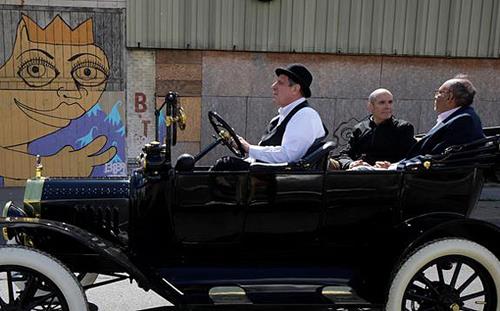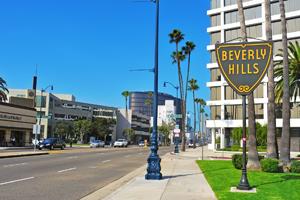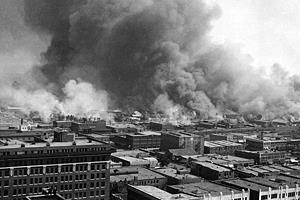
The idea that a street could “change America” might seem like an overreach until you think about it, at which point you immediately come up with at least two dozen that in a literal or figurative sense did just that.
PBS goes with a shorter list in 10 Streets That Changed America, which premieres at 8 p.m. ET Tuesday (check local listings) and kicks off another three-episode season of the popular 10 That Changed America series.
The other two episodes, which air the next two Tuesdays, are Monuments and Marvels. Just to be clear, “Marvels” is about things like the interstate highway system, not the Avengers and Iron Man.
Streets, written and produced by Dan Protess, skips a number of the thoroughfares you might think would be automatic, like Beale Street, Wall Street, and Bourbon Street.
Instead, it focuses on streets that reflected or helped lead to shifts in American culture and behavior.
That includes Woodward Avenue in Detroit (top), which became the first stretch of concrete-paved road in America.
Its greater significance stems from its conception as a transportation conduit by which workers could first take a trolley car to automobile assembly plants and eventually afford the automobiles with which they could drive on it themselves.
The original vision therefore was a multi-use roadway that would prominently offer mass transit. When its planning fell into the hands of automakers, the focus shifted almost entirely to cars.
From today’s perspective, that might seem logical and perhaps inevitable. 10 Streets points out that before automobiles, streets were places where people walked. Turning them over to large motorized vehicles was a radical shift.
It also necessitated some new engineering, since roads previously had consisted sometimes of gravel and, more often, of mud. Detroit wanted to make Woodward more friendly for drivers, so it was eventually both paved and widened – ideas that, it’s safe to say, caught on across the country.
One of the broader ironies of the American road, 10 Streets notes, is that many of the early highway planners saw wide roads and the increasingly popular automobile as a dream combination that would bring people into the cities.
As time passed, the opposite often happened. Roads gave people a way to leave, which helped lubricate the 20th century boom in suburbia and left cities like Detroit gasping for breath.
 In Los Angeles, naturally, some foresighted and lucky planners thought up Wilshire Boulevard, whose whole purpose was to bring drivers to a long stretch of road crowded with places to stop and shop. This wasn’t quite the same as sending people to suburban malls, obviously, but it was a related notion in that it envisioned people hopping in their cars to go shopping. In a city where weather was rarely an issue, Wilshire Boulevard helped pave the way for communities like Beverly Hills.
In Los Angeles, naturally, some foresighted and lucky planners thought up Wilshire Boulevard, whose whole purpose was to bring drivers to a long stretch of road crowded with places to stop and shop. This wasn’t quite the same as sending people to suburban malls, obviously, but it was a related notion in that it envisioned people hopping in their cars to go shopping. In a city where weather was rarely an issue, Wilshire Boulevard helped pave the way for communities like Beverly Hills.
10 Streets also goes back to a time before shopping malls, tracking New York’s Broadway to its origins as an early path for Native America trading routes that stretched as far as Canada.
Commerce, unsurprisingly, lay behind virtually all of the roads here. Commerce wasn’t always about making money, though. The Boston Post Road, from New York to Boston, became a key communications avenue for George Washington and the colonists who staged the American Revolution.
The outlier of 10 Streets also earned its place on this list because of its history, though it’s a history that does America considerably less proud.
Greenwood Avenue in Tulsa, Okla., was known by 1920 as the “Black Wall Street,” the main thoroughfare of a wealthy black community that had built its own institutions when it was shut out from the ones in segregated white Tulsa.
 Then on May 30, 1921, an alleged assault on a white girl by a black messenger sparked the total destruction of Greenwood Avenue and the surrounding community. Whites came in with a machine gun and firebombs that leveled every building, not to mention killing dozens or hundreds of residents.
Then on May 30, 1921, an alleged assault on a white girl by a black messenger sparked the total destruction of Greenwood Avenue and the surrounding community. Whites came in with a machine gun and firebombs that leveled every building, not to mention killing dozens or hundreds of residents.
Greenwood Avenue itself was just an innocent bystander. But it became a symbol of America’s racial pathology as surely as St. Charles Avenue in New Orleans became a symbol of the American exodus to suburbia.
10 Streets notes the hidden sociology behind many of its chosen routes, and it’s not all flattering. That’s all right. We should always know the paths by which we arrived to where we are today.